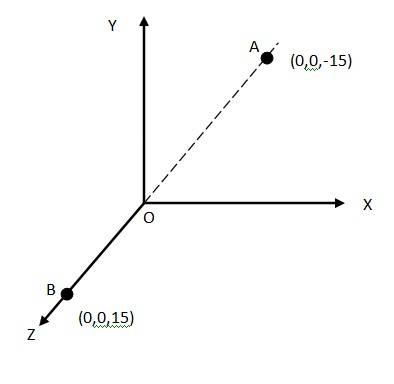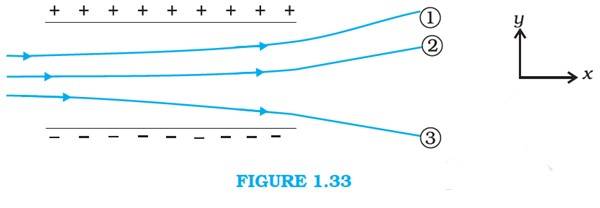Electric Charges and Fields
Get insights from 101 questions on Electric Charges and Fields, answered by students, alumni, and experts. You may also ask and answer any question you like about Electric Charges and Fields
Follow Ask QuestionQuestions
Discussions
Active Users
Followers
New answer posted
7 months agoContributor-Level 10
1.14 Since the charges 1 & 2 are attracted towards + ve, their charges will be – ve. The charge 3 is attracted towards – ve, hence its charge will be +ve.
The charge to mass ratio (emf) is directly proportional to the displacement, charge 3 will have the highest charge to mass ratio.
New answer posted
7 months agoContributor-Level 10
1.13 When the third uncharged sphere C is brought in contact with the sphere A, then the charge is shared and becomes half. Then
= and = =
When the charged sphere C is brought in contact with charged sphere B, the charge between both the sphere is shared and becomes half
(q + =
Hence the force of repulsion between sphere A and B can be given as
F =
, where = Permittivity of free space = 8.854 = = = =
=
= 5.695N
New answer posted
7 months agoContributor-Level 10
1.12 (a) Charge on sphere A, = 6.5 C
Charge on sphere B, = 6.5 C
Distance between the spheres, r = 50 cm = 0.5 m
Force of repulsion between two spheres
F =
, where = Permittivity of free space = 8.854
Therefore, F =
N = 0.0152 N = 1.52 N
(b) Charge on sphere A, = 2 6.5 C = 1.3
Charge on sphere B,
Distance between the spheres, r =
Force of repulsion between two spheres
F =
New answer posted
7 months agoContributor-Level 10
Ans.1.12
(a) Charge on sphere A,
Charge on sphere B,
Distance between the spheres, r = 50 cm = 0.5 m
Force of repulsion between two spheres
F =
(b) Charge on sphere A,
Charge on sphere B,
Distance between the spheres, r =
Force of repulsion between two spheres
F =
New question posted
7 months agoNew answer posted
7 months agoContributor-Level 10
1.11
(a) When polythene rubbed against wool, a number of electrons get transferred from wool to polythene. Hence, wool becomes positively charged and polythene negatively charged.
Amount of charge on the polythene piece, q = -3
Amount of charge of 1 electron e = -1.6
So number of electron transferred from wool to polythene
=
-
(b) Since electron has a mass, so there will be transfer of mass also.
Mass of single electron,
Total mass transferred from wool to polythene = 1.875
= 1.706
Hence a negligible amount of mass is transferred from wool to polythene.
New answer posted
7 months agoContributor-Level 10
Ans.1.10 Electric dipole moment, p = 4
C m
Angle made by p with a uniform electric field,
Electric field, E = 5
Torque acting on the dipole is given by
= 1
Therefore, the magnitude of the torque acting on the dipole is
New answer posted
7 months agoContributor-Level 10
1.9

At A, the amount of charge,
At B, the amount of charge,
= –2.5
Total charge of the system, q =
+
Distance between two charges at point A and B = 15 + 15 = 30 cm = 0.3 m
Electric dipole moment of the system is given by p =
New answer posted
7 months agoContributor-Level 10
1.8 (a) The situation is represented in the following figure.

O is the midpoint of AB, hence OA = OB = 10 cm = 10
The electric field at O caused by the charge at A is given by
where
Net electric field at point O, E =
=5.39
(b) A test charge of amount 1.5
So the force experienced by the test charge, F = q
= 1.5
N = 8.088
N
This force is directed along the line OA, this is because th
New answer posted
7 months agoContributor-Level 10
1.7
(a) An electrostatic field line is a continuous curve because a charge experiences a continuous force when traced in an electrostatic field. The field line cannot have sudden breaks because the charge moves continuously and does not jump from one point to another.
(b) The electric field intensity will show two directions at that point where two filed lines crosses. This is not possible. Hence they do not cross.
Taking an Exam? Selecting a College?
Get authentic answers from experts, students and alumni that you won't find anywhere else
Sign Up on ShikshaOn Shiksha, get access to
- 66k Colleges
- 1.2k Exams
- 680k Reviews
- 1800k Answers

